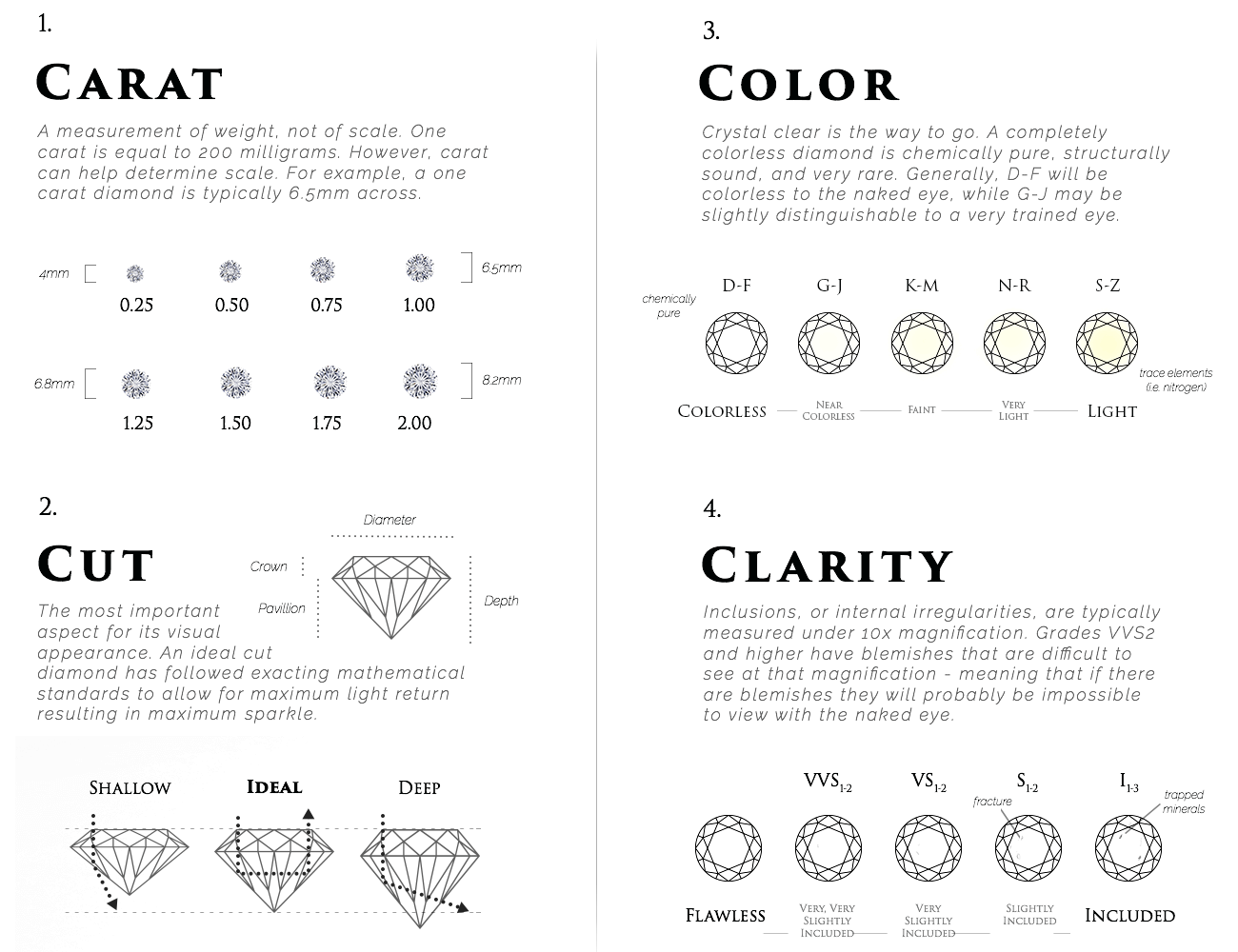THE FOUR C’S AT-A-GLANCE

1. CARAT
The carat is the diamond’s physical weight measured in metric carats. One carat equals 1/5 gram and is subdivided into 100 points. Carat weight is the most objective of the 4 Cs. It involves no estimates, comparisons or judgments. What carat does not determine is fire or scintillation. It only determines size and weight. Size and weight do, however, play a role in another “C” cost.
If cost is no object, then carat weight can play an important role in your diamond buying process. However, when you just buy for carats, you’re going to get a much less attractive stone than if you had bought the best cut, color, and clarity in your price range. A small, well-cut diamond with very good color and clarity will always look better than a larger stone with mediocre color, cut, and clarity.
In fact, of all the numbers in diamonds, carat weight has the least effect on the diamond’s appearance. Naturally, get the largest stone you can afford, but make sure it’s also the clearest, best cut, and most colorless stone for your budget. Balance is key.
2. CUT
Of all the 4 Cs, cut has the greatest effect on a diamond’s beauty. In determining the quality of the cut, the grader evaluates the cutter’s skill in the fashioning of the diamond. The more precise the cut, the more captivating the diamond is to the eye. The cut of the diamond is what gives the stone its brilliance and fire, which is what ultimately makes it sparkle and explode with prismatic color. Even a stone with relatively mediocre color and clarity can be brought to life by an exceptional cutter.
What cut boils down to is the way light enters and exits a diamond. In a well-cut diamond, light enters the top (the “crown” and the “table”) and exits the top, like it’s absorbing light and spitting it back out in fireworks. In diamonds that are cut too shallow or too deep, the light bleeds out the bottom and sides of the diamond, making it look smaller, darker, and altogether lifeless.
While there are ideal mathematical proportions that describe the angles and percentages needed to make an ideal cut diamond, what you’re interested in is the grading certification on the cut: look for Ideal, Excellent, and Very Good. More so than that, let your eyes be the judge. Does the diamond sparkle more than others?
3. COLOR
Gem-quality diamonds occur in many hues. In the range from colorless to light yellow or light brown. Colorless diamonds are the rarest. Other natural colors (Blue, Red, Pink for example) are known as fancy their color grading is different than from white diamonds.
Grades D-F are considered colorless
Grades G-J are considered near-colorless
Grades K-M are called faint yellow
Grades N-R are very light yellow
Grades S-Z are light yellow
Most stones in the D-G range are going to look almost identical to an untrained eye. At around H, you may start to see what professionals call “warmth” in the stone: you’ll see a very slight tint. After H, that tint becomes much more pronounced. The yellows here aren’t exactly a desirable shade: the diamonds often just look dirty.
For a white diamond, you’ll probably want to stay in the D-I range. An H or an I color diamond won’t look too different from a D, but it could be a lot less expensive.
4. CLARITY
Diamonds can have internal characteristics known as inclusions or external characteristics known as blemishes. Diamonds without inclusions or blemishes are rare; however, most characteristics can only be seen with magnification. Clarity is graded under 10-power (10x) magnification, though some clarity characteristics in the lower grades can be seen with the naked eye. These irregularities can include tiny crystals or bubbles, fissures, or other imperfections.
The grades are as follows:
FL – IF: Flawless – Internally Flawless. The rarest stones have no inclusions or blemishes visible to a trained eye with 10x magnification. These are exceptionally expensive.
VVS1 – VVS2: Very, Very Slightly Included. Inclusions that are very difficult to see by a trained grader under magnification.
VS1 – VS2: Very Slightly Included. Inclusions difficult to see under magnification, minor but visible when magnified.
SI1 – SI2: Inclusions visible under 10x magnification.
I1 – I3: Included. Usually visible to the naked eye. Diamond appearance affected and may impact durability.
A VS2 diamond or higher will not have inclusions you can see unless you plan on looking at your diamond with a microscope or jeweler’s loupe. The lower grades may be cheaper, but the inclusions may not make for the prettiest stone.

